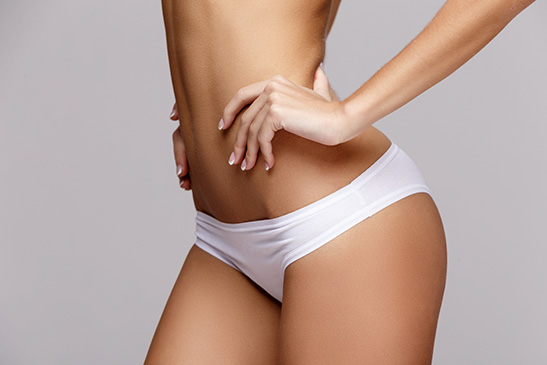Fat Transfer for Body
Conveniently located to serve the areas of London and Manchester

Fat transfer, also known as fat grafting or lipo injection, is a procedure that removes unwanted fat from an area of the patient’s body, and then transfers it to enhance the volume of other parts of the body.
Fat grafting is considered a more natural way to augment or restore volume, as it uses the patient’s own fat, rather than synthetic fillers or implants. It’s an attractive procedure for those interested in restoring their physique or creating a more youthful appearance while remaining natural. Fat transfer uses fat cells already present in your body, which means the procedure is fairly low risk, and versatile, and the fat is naturally biocompatible. (1) Additionally, fat transfer is a safe, effective procedure performed by Dr Riccardo Frati, who has years of experience, and a proven track record of successful results.
Dr Riccardo Frati will carefully analyze your medical history and current lifestyle factors before determining if you’re a candidate for the procedure. To set up a consultation with Dr Riccardo Frati, call +44 20 3633 2619 or fill out a contact form here. Dr Frati’s Harley Surgery practice has locations in London and Manchester.
Contents
- 1 Book your free consultation now
- 2 About Fat Transfer
- 3 Procedure Process
- 4 Fat Transfer for Breasts Recovery
- 5 Fat Transfer Candidates
- 6 Finding the Right Doctor
- 7 Personal Consultation
- 8 How Long Does Fat Transfer Last?
- 9 What Areas of the Body can be Treated with a Fat Transfer?
- 10 Preparing for the Procedure
- 11 What Are The Results of Fat Transfer?
- 12 Fat Transfer and Weight: Are They Connected?
- 13 How Much Does Fat Transfer Cost in London?
- 14 FAQ
- 15 References
About Fat Transfer
Fat transfer utilizes healthy, living fat cells from suitable parts of your body to enhance overall volume in another. Fat transfer is intended to accentuate areas with surface irregularities, uneven contours, or those lacking curvature. Fat grafting is also used for breast augmentation, radiation damage, burn injuries, and other deformities.(1) Common areas to harvest fat from include the thighs, flank, and upper and lower abdomen.
Procedure Process
First, fat is removed from several parts of the body where excess fat is present using liposuction or Micro Lipo. Once the fat has been extracted, it will go through a purification process to isolate healthy, pristine fat cells. Healthy cells are then able to be injected into the target area of the body that lacks volume.
While using VASER liposuction or Micro Lipo to harvest the fat, Dr. Frati is sure to make as few incisions as possible. These incisions are only 3 to 5 mm in size, and he will attempt to minimize scarring to the best degree. The purified fat is then injected where it is needed. Fat is evenly administered into the area where healthy tissue then acts as a protective barrier. This ensures that the distributed fat stays in contact with surrounding tissues that can provide oxygen and vital nutrients. The procedure typically takes around 1-2 hours, depending on the area and its size.
Fat Transfer for Breasts Recovery
There is a downtime period after a fat transfer procedure, however, the duration of downtime depends on factors like the patient’s resiliency and areas of the body that are treated. Patients typically recover within 1-2 weeks after a fat transfer for breasts, and it’s important to avoid strenuous physical activity for several weeks. Dr Riccardo Frati will intricately describe the recovery process and estimated downtime during your personal consultation.
Fat Transfer Candidates
Individuals who are seeking to fill specific parts of their body that lack volume are suitable for fat transfer. To be a good candidate for fat transfer, there are a few criteria patients will need to meet. Patients should be in good health before sustaining the procedure, and should not be faced with any history of abnormal bleeding or inflammation beforehand. Patients who smoke will need to quit several weeks before their procedure and for the duration of their recovery, as nicotine constricts blood vessels and inhibits healing.
Finding the Right Doctor
Before making a decision to proceed with fat transfer, a personal consultation is the required first step. Finding the right doctor is crucial, and there is no better surgeon to choose from than Dr Riccardo Frati. A decorated and experienced surgeon, Dr Riccardo Frati has practised internationally. Dr Riccardo Frati’s work has even been mentioned in the Daily Mail, The Independent, and other top media outlets. With his established, world-renowned reputation and incredibly successful results, Dr Frati is bound to make you feel confident on your aesthetic journey.
Personal Consultation
During a personal consultation, Dr Frati will begin by reviewing your medical history, current lifestyle habits, and your personal needs. Together, you will engage in a conversation based on why you’re interested in fat transfer and which areas of your body are suitable for the procedure. Then, Dr Frati will answer any questions or concerns you may have and walk you through the pre and post-surgery process. There is no rush-through with a personal consultation. This significant appointment serves the purpose of ensuring comfortability, knowledge, and outlining a treatment plan. If you’re interested in setting up a personal consultation, call the office at +44 20 3633 2619 or fill out a contact form here.
How Long Does Fat Transfer Last?
Once the fat transfer procedure has been achieved, it takes fat cells about six months to become fully established in their new location. From that point on, results should last many, many years. However, as you age and your body changes, you may want to consider additional treatments to maintain your desired shape and youthful appearance. It’s important to note that because these are living fat cells, the area will respond naturally to fluctuations in weight. Patients should be sure to maintain a stable weight in order to preserve their results.
What Areas of the Body can be Treated with a Fat Transfer?
Fat Transfer for Breasts
Harvested fat can also be delicately injected into layers of the breasts, which then enhances shape, plumpness, and proportion. This is also known as a natural breast augmentation. Fat transfer for breasts is much less invasive than traditional breast augmentation with implants, although both procedures are exceptionally transformative procedures. However, patients who opt for a breast augmentation with a fat transfer have the ability to achieve natural-looking results without the risks that accompany silicone implants and avoid the need for future implant revisions.
Preparing for the Procedure
Your surgeon will thoroughly walk you through preoperative instructions, all of which are essential to follow to ensure the best possible experience and results. During the personal consultation and any other appointments leading up to the procedure, your surgeon will collect all information about your medical history and physical wellness which will dictate your preoperative instructions.
It is highly recommended that patients’ blood oxygen level, nutrition, and general health are optimized in the time leading up to treatment. The better the patients’ health, the more likely it will be that the graft will receive maximum nutrition and proper blood flow following the procedure. (2)
Fat Transfer Preoperative Instructions
- Stop smoking at least six weeks prior to the procedure to avoid inflammation, and ensure proper wound healing as well as minimal scarring
- Make sure to stay well-hydrated in the weeks leading up to the procedure
- Avoid taking anti-inflammatory medications and certain blood thinners such as aspirin. Certain vitamins and homeopathic regimens can increase bleeding, so be sure to inform Dr Frati about any medications or supplements that you are taking.
- Stock up on food, water, and supplies that you will utilize post-treatment. Wear comfortable, loose clothing and arrange for someone to pick you up from the procedure and stay with you for at least 24 hours after surgery.
What Are The Results of Fat Transfer?
After patients have undergone the fat transfer procedure, they can expect to see more volume, plumpness, and proportionate shape in the body’s injected areas. Fat transfer can also fill in wrinkles, rid the area of fine lines, and enhance the skin’s appearance. Results of fat transfer will look different on every patient, and your surgeon will be able to provide an accurate description of the results and procedural outcome.
Fat Transfer and Weight: Are They Connected?
It is important to note that fat transfer is not a weight loss solution. The primary purpose of fat transfer is to enhance shape, contour, and volume. Patients should be at a stable weight, and able to maintain it in order to ensure the best results. Losing a significant amount of weight can cause you to lose fat that will need to be extracted and harvested, and can also diminish the effects of the procedure afterwards. Your surgeon will discuss any relevant concerns about your weight before the procedure.
How Much Does Fat Transfer Cost in London?
The cost of a fat transfer will depend on a number of factors, including the areas being treated, the amount of fat being transferred, and the number of injections required to achieve your desired results.
During your consultation, Dr. Riccardo Frati will be able to provide an accurate price after determining a procedural plan. You can reach any of Dr. Riccardo Frati’s London and Manchester locations through the surgical line at +44 20 3633 2619, or fill out an online contact form.
FAQ
How long does swelling from fat transfer last?
Most of the swelling from fat transfer will be noticeable in the first and second week post-treatment. From that point on, swelling will begin to subside, and you will start to notice a decrease in redness and puffiness. Swelling typically fully resolves after about two months.
In what areas can fat be grafted in the body?
Fat can be grafted in the body in any area where subcutaneous fat already exists.
Where is the fat removed from?
The fat will be extracted from any area where you have excess fat, such as the inner and outer thighs, lower back, hips, and lower abdomen.
Is fat grafting permanent?
During grafting, some of the fat survives while other cells do not. However, a large amount of the fat typically does survive.
What weight should patients be for fat grafting?
There is no weight requirement for fat transfer, so long as patients have enough fat to reserve, harvest, and graft. However, as with any surgical procedure, patients should be at or near a healthy BMI to ensure that they can undergo surgery safely.
How much fat will be needed for fat grafting?
Dr. Riccardo Frati will not take out any more fat than is absolutely needed for grafting. Over injecting is a fine line when it comes to the fat transfer process, and Dr. Frati is an expert on how much to extract and inject.
References
- Strong AL, Cederna PS, Rubin JP, Coleman SR, Levi B. The Current State of Fat Grafting: A Review of Harvesting, Processing, and Injection Techniques. Plast Reconstr Surg. 2015;136(4):897-912. doi:10.1097/PRS.0000000000001590
- Shauly, Orr BS, Gould, Daniel J. MD, PhD, Ghavami, Ashkan MD. Fat Grafting: Basic Science, Techniques, and Patient Management, Plastic and Reconstructive Surgery – Global Open. 2022;10(3):3987doi: 10.1097/GOX.0000000000003987
- Bellini E, Grieco MP, Raposio E. The science behind autologous fat grafting. Ann Med Surg (Lond). 2017;24:65-73. Published 2017 Nov 10. doi:10.1016/j.amsu.2017.11.001










